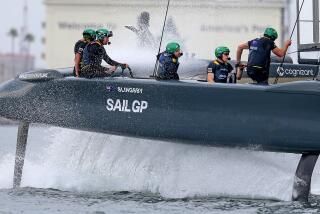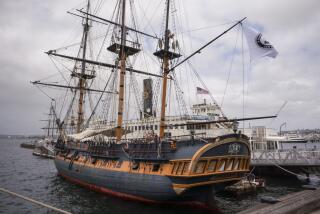It Takes High Seas of Support to Keep $tars & $tripes Afloat
Malin Burnham had a sheepish, almost guilty, smile on his face. He looked the way I look when a freckle-faced 9-year-old in pigtails stands at the front door selling Girl Scout cookies, and I have already ordered 22 boxes.
However, in Burnham’s case, he was selling rather than buying.
The occasion was a news conference at the Hotel Inter-Continental, a gathering to hear Burnham and Dennis Conner report on the America’s Cup challenge series in Fremantle, Australia.
Indeed, everything was going quite nicely for Stars & Stripes, San Diego’s entry in this marathon yachting extravaganza.
“In a nutshell, we’re in great shape,” said Burnham, the chairman of the sponsoring Sail America Foundation. “We’re doing very well in all departments except one. Fund raising.”
Aha. The hook.
Burnham cleared his throat and adjusted his tie.
“I know that the press and the media aren’t the people to go to,” he said. “I respect this line of demarcation.”
It’s more than a line of demarcation, Malin. The collective net worth of the reporters in attendance probably would not have been enough to purchase a sail. I’m still trying to rebuild my savings after being pillaged by the Girl Scouts.
“We’re budgeted for $15 million,” Burnham continued, “and we’ve raised $11 million. But that’s my responsibility, not yours.”
Fifteen million dollars.
I don’t know what $15 million will buy in The Real World, because I have never had cause to contemplate numbers of that magnitude. In fact, I just had to borrow a dime to get the correct change for the soft drink machine, and that wasn’t easy to do in the newsroom. I had to write out an IOU.
Fifteen million dollars?
What do they have on those yachts? Hot tubs? Wide screen televisions? Wet bars? Round beds? Mink couches? Quadraphonic sound systems? Or symphony orchestras?
None of the above? Preposterous.
These yachts are as Spartan below decks as any Roman galley. Not an ounce (or dollar) is wasted on anything that will not enhance speed. Anything that will not make these yachts go faster is stripped, because any weight with no function makes them go slower.
That being the case, I return to my previous bewilderment.
Fifteen million dollars!
These yachts don’t even come with engines . . . and appurtenant expenses. How much does it cost for a gallon of air?
I have heard it said that supporting a yacht is like pouring money into a hole in the water. If I don’t have that quite right, understand that I have been listening to Joe Garagiola trying to make sense for a few evenings and I might be a bit punchy. My point is that it takes a substantial hole in anything to hold $15 million.
Later, after the news conference and a viewing of a videotaped America’s Cup update, I pulled Burnham aside. I was tempted to ask him if Sail America was perhaps building a hotel in Fremantle, but decided against it.
“Where,” I asked, “is the $15 million being spent?”
I felt almost apologetic. This guy is one of the most respected businessmen in San Diego, and here I was treating him like he’d blown the grocery money.
“Our first priority,” Burnham said patiently, “was design. We built software for computerized design. It was similar to aircraft design. We wanted to convert naval architecture from an art to a science.”
The tab for this was $3.5 million.
“We bought two new boats,” he continued, “and rebuilt one of them. And we built three new boats from scratch.”
Tab: $3.8 million.
My mind whirred with the precision of computer software and spit forth $7.3 million. Hmmm. That much did not get the yacht into the water, get a crew onto the deck or sails onto the mast.
Burnham was not finished.
There was the cost of transporting all five boats to Hawaii for prechallenge trial runs. Two boats were shipped to Australia and three returned to San Diego. A tender was also shipped to Hawaii and to Australia.
“It’s not cheap transporting 12-meters,” Burnham said.
Tab: $500,000.
Then there’s the crew. Although the “starting lineup” is 11 men, Sail America is transporting, housing and feeding 28 crewmen. Conner must subscribe to John McNamara’s theory that rested athletes perform better.
“None of the crew are paid,” Burnham said. “They get $75 a week in subsistence pay, in case they need a tube of toothpaste or want to go to a movie.”
Tab: $2 million.
Now, let’s see, this group is called Sail America. There must be another expense.
“Our sail inventory,” Burnham said, “is $1.7 million.”
I was amazed. These guys must have enough canvas to cover Yellowstone. Of course, sails are not really made of canvas these days. I’m not sure what they are made of, unless maybe it’s silk. One sail can cost as much as a luxury car . . . with chauffeur.
This was the big stuff. The total comes to $11.5 million.
I wasn’t keeping a running total as we talked, my mental calculator having frozen after it hit $7.3 million on the first two items. Since there must be considerable miscellaneous expense, it’s not for me to question the whereabouts of a paltry $3.5 million.
After all, I know how it is with budgets. Every time I set one up and start feeling like I have every contingency covered, the dryer won’t dry or the disposal won’t dispose . . . or the Girl Scouts start another one of their cookie drives.
More to Read
Sign up for The Wild
We’ll help you find the best places to hike, bike and run, as well as the perfect silent spots for meditation and yoga.
You may occasionally receive promotional content from the Los Angeles Times.






